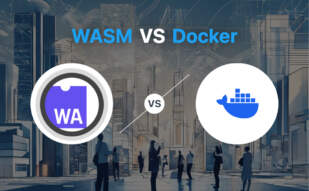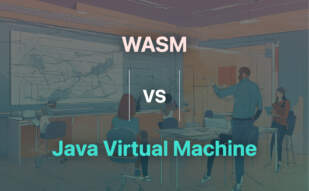For portability and high-speed performance in web browsers, WASM is the clear best choice. WASM lets developers reuse libraries across diverse languages and is especially effective for AR/VR applications. On the other hand, Containers provide an isolated environment for apps, offering enhanced portability, and thus fit best for large-scale infrastructure software.

Key Differences Between WebAssembly (WASM) and Containers
- Coding: WASM primarily employs low-level binary format allowing code from multiple languages to run at near-native speed. Containers essentially use Docker’s container-based platform for creating isolated workspaces.
- Scope: WASM improves website performance and capabilities extensively and is suited for intense use cases like VR, AR, image/video editing. Containers are ideal for large-scale software infrastructure providing consistency and swift deployment.
- Security: WASM improves application security by reducing vulnerability attack surface and providing better memory safety. Containers provide isolation and security enabling many containers to run simultaneously on a host.
- Performance: WASM enhances developer productivity, mitigates the need for specific app runtimes. Containers, being lightweight and faster than virtual machines, enhance software portability and deployment speed.
- Adoption: Languages that can be compiled to WebAssembly include C, C++, Rust, Go. Containers are primarily integrated via Docker with access to Kubernetes for management.
| Comparison | WebAssembly (WASM) | Containers (Docker) |
|---|---|---|
| Established Year | 2017 | 2013 |
| Major Use Cases | Video editing, 3D games, VR/AR, P2P services, scientific simulations | Software portability, deployment consistency |
| Unique Feature | Original code can be compiled to WASM binary, run inside browsers | Highly isolated environment for apps and dependencies |
| Performance | Low-level binary format for high performance, close to native execution speed | Lightweight and fast performance |
| Security | Reduced vulnerability attack surface, improved memory safety, sandboxing | Secure, isolated workspace |
| Contribution to Developer Productivity | Avoids catering to specific app runtimes, enhances performance of JavaScript-dependent applications | Isolation leads to robust, consistent deployment across different environments |
| Extra Functionality | Can be applied for Serverless environments, useful with JavaScript frameworks | Manageable with tools like Ceph, REX-Ray, Flannel, Jenkins |
| Development Trend | Growth in AR/VR applications, edge-based environments | Greater adoption in serverless technology, hybrid cloud solutions |
What Is WebAssembly (WASM) and Who’s It For?
Established in 2017 and becoming a W3C standard by 2019, WebAssembly (WASM) is a game-changer for the tech industry, enhancing website performance and capabilities extensively. It’s supported by all major browsers and it ushers in a new era of near-native speed web applications while complementing and working alongside JavaScript. From video editing and 3D games to virtual/augmented reality, P2P services and scientific simulations, WASM’s widespread applications have attracted a range of users including web developers, data scientists, software engineers, and digital innovators.
With its efficient and high-speed performance, it is particularly effective in navigating performance issues in JavaScript for more intensive uses like VR, AR, and image/video editing. WASM holds major implications for the web platform, activating client apps previously unable to function due to performance constraints. Developers, start-ups, tech companies, and enterprises who aim to take advantage of the latest in web application technology will find a valuable tool in WASM.

Pros of WebAssembly
- Enhances website performance and capabilities
- Compatible with all major browsers
- Can run at near-native speed effectively
- Enables running code written in multiple languages
- Improvement of web apps security and developer productivity.
Cons of WebAssembly
- Compiling to WASM might add to the development time
- Certain in-browser use cases are still limited
- Memory management might be complex for some developers
- Steep learning curve for developers new to this technology
What Is Docker and Who’s It For?
Docker is an open platform that revolutionizes the way software is created, shipped, and run. It isolates applications into containers, enhancing software portability, consistency, and swift deployment. Regardless of the hosting environment, operating system, or hardware, Docker ensures that your applications function seamlessly and efficiently. It’s built for developers, system administrators, architects, and anyone needing a straightforward way to package and run applications.
Started in 2013, Docker’s impact on large scale software infrastructure cannot be overstated. From providing isolation and security to enabling the running of multiple containers simultaneously, it has streamlined the deployment process considerably. Container management is further made easier with Docker providing platforms and tools to manage the lifecycle of containers. It’s widely used in the tech industry, from small startups to global corporations, and continues to influence the trends of container technology.

Pros of Docker
- Enhances software portability and consistency
- Ideal for creating isolated environments for apps and their dependencies
- Lightweight and faster than hypervisor-based virtual machines
- Provides platforms and tools to manage the lifecycle of containers
Cons of Docker
- Security can be a concern if not properly implemented
- Unsolved problem with Docker’s ecosystem not facilitating automatic gathering and publishing of source code
- Using Docker in high-performance computing environments can be complex
- Shared data storage and networking can be challenging
Code Examples for WASM & Containers
WASM
Our WASM snippet showcases how to make a simple alert system. You’ll need to assemble this with Emscripten.
(module
(import "env" "alert" (func $alert (param i32)))
(memory (export "memory") 1)
(data (i32.const 0) "Hello, World!")
(export "main" (func $main))
(func $main
(call $alert
(i32.const 0)
)
)
)Containers
For Containers, our example illustrates Dockerfile, building a basic NGINX server inside a Docker container. Docker and NGINX should be pre-installed to fulfill the prerequisites.
# Base Image
FROM nginx:latest
# Define Work Directory
WORKDIR /usr/share/nginx/html
# Copy static website to Work Directory
COPY . .
# Expose port 80
EXPOSE 80
# Start NGINX
CMD ["nginx", "-g", "daemon off;"]Remember, you need to substitute “undefined-numbers lang-js” with the respective “lang-wasm” for WASM code and “lang-dockerfile” for Dockerfile as per the Prism format, enabling pleasing visuals and better legibility in any blog post.
WebAssembly VS Containers: The Final Showdown
In this evolving digital arena, deciding between WebAssembly and Containers depends largely on your professional needs and the nature of your applications.
Developers Seeking High-Performance Web Experiences
If you’re developing software for intensive use cases like VR, AR, image/video editing, or computer vision, WebAssembly is your go-to. With byte code execution enabling near-native speed and robust compatibility across major browsers, WASM improves website performance exponentially. The unique ability to compile original code to WASM binary simplifies your development process, eliminating the need for creating WebAssembly code.

Serverless Enthusiasts
For the lovers of serverless environments, WebAssembly shines once more. It mitigates adoption issues and its compact instruction format, alongside better memory management reduces vulnerability attack surface, making it a secure option. Furthermore, utilizing frameworks like wasmCloud extends its security footprint, further easing your workload.

Containers’ Advocates
If you need software portability, containers come to the rescue. Its isolation capabilities allow it to run unaffected by hosting environment, operating system, and hardware variations. For fans of Docker, Kubernetes, and other container technologies, Containers provide a familiar and efficient landscape.

Kubernetes-centric Projects
Should your focus be on Kubernetes-based projects, Containers hold the reins tight. The continuous integration of container management platforms like Ceph, REX-ray, Flannel, and Jenkins into Docker technology, alongside Docker’s own native segregation tactics, provides an enhanced Kubernetes-centric environment.

In conclusion, if web performance and serverless are your top priorities, choose WebAssembly. However, for portability and Kubernetes-centric projects, opt for Containers.
Logan Bellbrook
Content writer @ Aircada with a knack for nature & AR/VR/XR. Blogging the intersection of tech & terrain.





